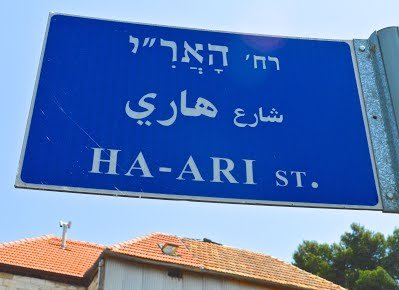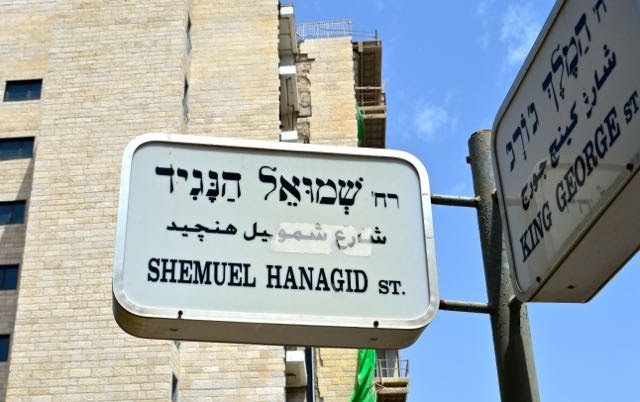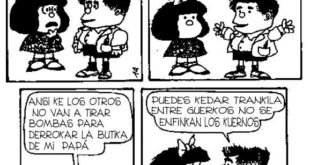Text and photos by Daniel Santacruz
The Rechavia neighborhood of Jerusalem, established in 1921, is the only one in the city that has streets named after Sefardic poets, rabbis and scholars, most of them from the Golden Era of Spain.
Yehuda Halevy, born in the northern Spanish city of Tudela and author of The Kuzari and some 800 poems, had a street named after him too, but in 1933 its name was changed to Ussishkin Street in a controversial move.
Following is a gallery of pictures of the 14 street signs with a short biography of each of the scholars.
 Ha-Ari Street
Ha-Ari Street
Named after Rabbi Isaac Luria Ashkenazi, known as Ha-Ari. (“The Lion”). Born in Jerusalem’s Old City in 1534 of an Ashkenazi father and a Sefardic mother, he is the creator of the Lurianic Kabbalah. His customs and style of prayer, and that of his circle of Sefardic rabbis in the city of Safed, is known as Nusach Sefard, which has been adopted by some Hasidic Jews. A variation of that nusach is called Nusach Ari.
Although his connections to Spain are apparently non-existent, the city of Jerusalem considered him influential enough among Sefardim and Oriental, or Mizrahi, Jews to honor him with a street.
Samuel Hanagid Street
Named after Samuel Hanagid, known also as Samuel ibn Nagrela, born probably in Merida, in western Spain, in 1049. He served as visir of Granada, and wrote poetry and commentaries on the Talmud.

 Ibn Shaprut Street
Ibn Shaprut Street
Named after Hasdai ben Isaac Shaprut. Born in 915 in Jaen, in southern Spain, he was a physician, a botanist and a diplomat. He was minister of Abderrahman III in Cordoba, where he died.
 Rashba Street
Rashba Street
Named after Rashba, acronym of Rabbi Shlomo ben Adret. Born in Barcelona in 1235, he was a banker and a rabbi, and author of several commentaries on the Kabala as well as responsa. He was a pupil of rabbis Moses ben Naḥman Girondi, known also as Ramban, and Yona, both born in Gerona, Catalonia.
Ramban Street
 Named after Ramban, the acronym of Rabbi Moses ben Naḥman Girondi. Born in Girona in 1194, he was a physician, philosopher and kabalist. He was also known as Bonastruc ca Porta or Nachmanides.
Named after Ramban, the acronym of Rabbi Moses ben Naḥman Girondi. Born in Girona in 1194, he was a physician, philosopher and kabalist. He was also known as Bonastruc ca Porta or Nachmanides.
He lived in Jerusalem’s Old City, where he established a synagogue that still exists. The street is located next to that of another Catalonian rabbi, Rashba.
Ibn Gevirol Street
Named after Salomon Ibn Gevirol, or Gabirol, who was born in Malaga, possibly in 1021 or 1022. Author of a philosophical work, Fons Vitae (The Fountain of Life), and author of several poems, both in Hebrew and Arabic. The well-known liturgical song “Adon Olam” has been attributed to him. Known also as Avicebron.

Abarvanel Street
 Named after Isaac Abarvanel, who was born in Lisbon in 1437. He served as adviser and financier to kings in Spain, Portugal and Naples, and wrote several Biblical commentaries. Other members of the Abarvanel family were Judah, born in Seville in 1310 and grandfather of Isaac, and Judah, or Leon Ebreo, son of the former.
Named after Isaac Abarvanel, who was born in Lisbon in 1437. He served as adviser and financier to kings in Spain, Portugal and Naples, and wrote several Biblical commentaries. Other members of the Abarvanel family were Judah, born in Seville in 1310 and grandfather of Isaac, and Judah, or Leon Ebreo, son of the former.
Yehuda Al-Harizi Street
 Named after Yehuda Al-Harizi, who was born in 1165, possibly in Toledo. His most famous work is Tahkemoni (The Wise One), a book of poetry. Fluent in several languages, he wrote long poems in both Arabic and Hebrew, translated and traveled extensively.
Named after Yehuda Al-Harizi, who was born in 1165, possibly in Toledo. His most famous work is Tahkemoni (The Wise One), a book of poetry. Fluent in several languages, he wrote long poems in both Arabic and Hebrew, translated and traveled extensively.
Ibn Ezra Street
Named after Abraham Ibn Ezra, Biblical commentator, poet and grammarian, who was born in Tudela in 1089. His commentaries appear in several editions of the Pentateuch, next to those of Rashi and Ramban. Ironically, the street is also located next Ramban’s.
Alfasi Street
Named after Isaac ben Jacob Alfasi ha-Cohen, who was born in Al Qal’a, Algeria, in 1013. He spent most of his life in Fes, Morocco, but in 1089 was forced to move to Lucena, in southern Spain, where he established a yeshiva. Author of several books on Jewish law. Some of his pupils were Ibn Gabirol and Yehuda Halevi.

Mitudela Street
Named after the famous traveler, who was born in Tudela, in 1130. Little is know about his life before he set on a trip that took him all over the known world and that lasted many years.
A result of that journey was his book The Travels of Benjamin, which chronicles his experiences through Europe, Asia and North Africa, and offers a glimpse of life in several Jewish communities. It is not known when he left Spain, but came back in 1172 or 1173 via Sicily.

 Radak Street
Radak Street
Radak is the acronym of Rabbi David Kimchi, biblical commentator, grammarian and philosopher, born in Provence, southern France, in 1160. His grammar lexicon, Michlol, is considered a classic. His father, Joseph, and David’s brother, Moshe, were also grammarians. Joseph was born in southern Spain and migrated to Provence.
Dunash ben Labrat Street
 Named after the poet and grammarian, believed to have been born in Fez in 920. He worked as a rabbi in Cordoba, where he possibly died.
Named after the poet and grammarian, believed to have been born in Fez in 920. He worked as a rabbi in Cordoba, where he possibly died.
His attacks against another Hebrew grammarian also born in Spain, Menahem ben Saruk, make fascinating reading, if one is into the fine points of the grammar of the Holy Tongue. Along with the latter and Joseph and David Kimchi, ben Labrat is considered one of the founders of Hebrew linguistics.
 Ben-Maimon Harambam Street
Ben-Maimon Harambam Street
Named after the biblical commentator, physician and astronomer, who was born in 1135 in Cordoba. Died in Egypt 69 years later.
The street sign is the only of the ones mentioned here that includes his name and acronym, and that is «sponsored» by a realtor that caters to English speakers. The street is equal in length to Ramban’s—four blocks long.
© Daniel Santacruz
May 2016
Fuente: sites.google.com/a/kolsefardim.net
 eSefarad Noticias del Mundo Sefaradi
eSefarad Noticias del Mundo Sefaradi

